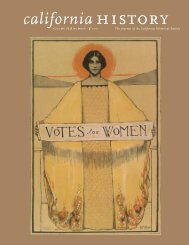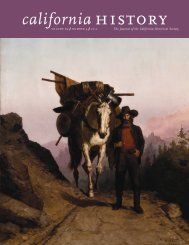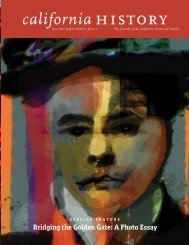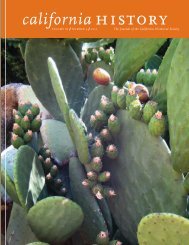Volume 90, Number 1 - California Historical Society
Volume 90, Number 1 - California Historical Society
Volume 90, Number 1 - California Historical Society
You also want an ePaper? Increase the reach of your titles
YUMPU automatically turns print PDFs into web optimized ePapers that Google loves.
52<br />
Neither pheasant nor geese could have been all<br />
that plentiful, because by all accounts the most<br />
common meal for entertaining purposes was<br />
Miller’s “bandit luncheon,” a meat stew with<br />
onions and vegetables cooked in a large pot over<br />
an open fire for two to three hours. A variation<br />
was the “Hungarian bandit luncheon,” a<br />
kebob of small steak, bacon, and a slice of onion<br />
on skewers. 37 From the early 18<strong>90</strong>s, when the<br />
Hights began to welcome a steady stream of<br />
both transient and resident Japanese, the cuisine<br />
diversified to include tea and sushi. Goose or<br />
kebob, these meals took place among the redwoods<br />
in the canyon along Palo Seco Creek on<br />
the property’s northern border, or near the Abbey<br />
under what was variously described as an arbor,<br />
an arbor with roses, or “a bower of white roses.”<br />
In unseasonable weather, the repasts were moved<br />
a dozen yards east to Margaret Miller’s, Joaquin’s<br />
mother’s, winter cottage. 38<br />
The guest list of one such bandit lunch combined<br />
Berkeley artist William Keith and his<br />
wife; the author Cora Older, wife of local editor<br />
and reformer Fremont Older; the author Bailey<br />
Millard, at the time in between San Francisco<br />
and New York editing jobs; and resident artist<br />
and aristocrat the Hungarian count Geyza S.<br />
de Perhacs. All during his Oakland period, but<br />
especially in the early 19<strong>90</strong>s when he was a<br />
stringer, Miller drew heavily from his acquaintances<br />
among the contributors and staff at the<br />
venerable San Francisco Morning Call (after 1895,<br />
the San Francisco Call). One dinner was prefaced<br />
by a pitcher of water containing one of Miller’s<br />
stocks of goldfish, described by guest and Call<br />
“auditor” Howard Hurlbut, a would-be poet and<br />
recent sojourner among the Crow Indians. Also<br />
in attendance were Ethel Brandon, a local leading<br />
lady, and her sister, a poetry contributor to the<br />
Call. To honor the departing New Yorker Edmund<br />
Russell, Upper Fruitvale’s most prominent<br />
host again called upon poets, in this instance<br />
Edwin Markham, David Lesser Lezinsky, and<br />
Coolbrith. 39<br />
<strong>California</strong> History • volume <strong>90</strong> number 1 2012<br />
Although Miller was inclined toward more intimate<br />
entertaining, near the end of his presence in<br />
Fruitvale Heights he also annually held what he<br />
called Whitaker Day, in honor of Herman “Jim”<br />
Whitaker, his wife, and their seven children. 40<br />
The son of English wool manufacturers, Whitaker<br />
had arrived in Oakland in 1895. He worked odd<br />
jobs while moving his family from one cheap<br />
immigrant neighborhood to another. Eventually,<br />
this close confrere of Miller’s was to enjoy success<br />
with his novel The Planter, an exposé of conditions<br />
on Mexican rubber plantations.<br />
Superficially, Whitaker shared much in common<br />
with John Herbert Evelyn Partington, another<br />
intimate. Both men were British, Oakland-based,<br />
and the father of seven children. The resemblance<br />
ended there, however, because Partington,<br />
a graphic artist, had a going business, a school<br />
for newspaper illustration. Also, in contrast<br />
with Whitaker’s earthier progeny, the Partington<br />
children were destined to become artists of one<br />
kind or another. Gertrude painted Miller’s portrait.<br />
Blanche and Richard were familiar figures<br />
at the Hights. Blanche, the Call’s drama and<br />
cultural critic and a much-admired beauty, was<br />
a confidante of Ambrose Bierce and a source of<br />
romantic interest for Noguchi. 41 Until the quake<br />
wreaked havoc with the city’s theaters and art<br />
schools, young Dick worked at the family’s San<br />
Francisco school. Afterward, he ran the art gallery<br />
that real estate developers Francis Marion<br />
“Borax” Smith and Frank Havens opened in the<br />
upscale suburb of Piedmont.<br />
As Havens’s nephew and right-hand man,<br />
George Sterling would have been instrumental in<br />
securing the gallery position for Dick. A wouldbe<br />
poet, Sterling was the dashing, unannounced<br />
leader of a group of young men that included<br />
Dick, Ambrose Bierce’s younger son, Leigh,<br />
and the journalist Austin Lewis, who along with<br />
Bierce’s brother Albert and his son Carleton were<br />
regular imbibers of Miller’s store of 110 proof.









